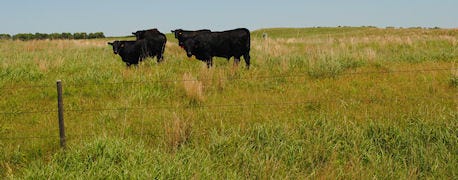July 3, 2014

Wet soils in alfalfa fields right after cutting will certainly do one thing. It will help weedy grasses like foxtail and crabgrass grow.
So, how do you reduce the amount of foxtail and other weedy grasses in your hay? Bruce Anderson, University of Nebraska-Lincoln forage specialist, says the best way to start is to keep your alfalfa thick and thrifty so it will compete aggressively with invading foxtail. Thick initial stands and good soil fertility are needed.
In addition, harvest alfalfa only after it begins to bloom or when new shoots appear at the base of the plants. Then alfalfa should regrow rapidly so foxtail doesn't get much time to become a problem, according to Anderson.

UNL Specialist Offers Forage Tips for Summer
"Unfortunately, this method often is easier said than done. It also may sacrifice some forage quality since harvest occurs after bloom begins. So this method may not solve all your problems."
Related: Get Broomsedge Out of Your Pasture and Hay Land
Herbicides are another option. Roundup works great, but only for Roundup Ready varieties, he warns. In conventional alfalfa, two herbicides that control annual grasses are Select Max and Poast Plus. These herbicides work well on seedling grasses that are less than 4 inches tall, and alfalfa tolerates both herbicides very well, he adds.
Another herbicide option, but a much more risky option, is Gramoxone xtra. Gramoxone burns back top growth of all green plant material. "This will kill most annuals like foxtail, but it also can injure alfalfa regrowth that has already emerged. Therefore, only use Gramoxone immediately after harvest and before any new regrowth shoots appear. None of these herbicides have any soil residual activity, so good plant coverage is necessary and you may need to repeat the spraying if new weeds emerge," Anderson says.
A number of producers have noticed an abundance of sweet clover this summer. This can be good or bad, depending on how it may affect your pastures, your hay, and your cattle, Anderson says.
"In many situations, I like sweet clover. Sweet clover is a legume and is able to produce its own nitrogen. In fact, sweet clover can provide more nitrogen for adjacent grasses than most other legumes. So your pastures might get a production boost following a heavy sweet clover year," he says.
It also provides good quality grazing similar to alfalfa before plants bloom heavily. After blooming, though, like now, plants get stemmy and woody, reducing both feed value and palatability. Even young plants are quite bitter, so if other plants are available to graze, cattle eat only limited amounts of sweet clover. This greatly reduces bloat hazards, which is a risk when sweet clover is abundant.
Related: How We Count the Cows in a Pasture System is Important
"Your biggest risk from sweet clover is in hay, and specifically, in moldy hay," he says. "Spoiled sweet clover produces a chemical called dicoumarin that interferes with metabolism and synthesis of vitamin K. Without vitamin K, blood will not clot properly after an injury and blood can even seep out of otherwise healthy blood vessels. That's why sweet clover poisoning also is called sweet clover bleeding disease."
Make sure hay containing sweet clover is extra dry before baling or storing to prevent mold, he recommends. "And remember that mold can develop on perfectly dry bales if they get wet, so outdoor storage is risky. If you must feed moldy sweet clover, alternate by feeding moldy hay for a week followed by alfalfa or other non-moldy forage for a week. This intermittent feeding is safer than mixing good and moldy hay together."
You May Also Like




